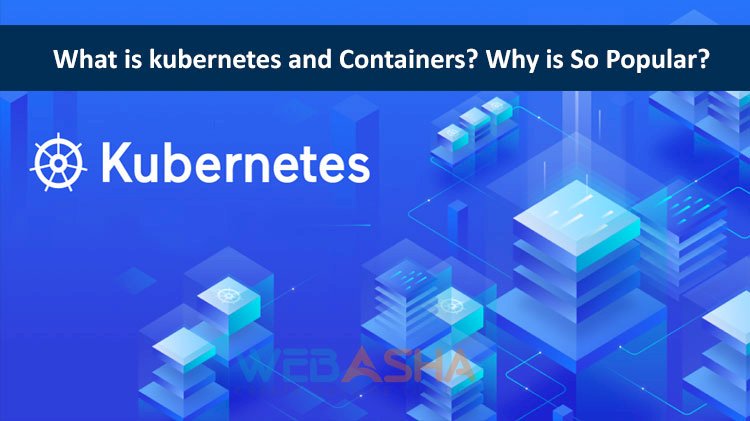What is kubernetes and Containers? Why is So Popular?
Kubernetes developed by Google, Kubernetes is an extensible, portable, open-source platform designed to automate scaling, deployment, and management of containerized workload and services

Originally Kubernetes developed by Google, Kubernetes is an extensible, portable, open-source platform designed to automate scaling, deployment, and management of containerized workload and services. It also helps facilitate both automation and declarative configuration. Kubernetes has a rapidly growing ecosystem that has widely available services, support, and tools. The Kubernetes project was open-sourced by Google in 2014.
In practice, Kubernetes is usually used with the most popular containerization platform, Docker. However, it also can be used with other container systems, as long as they conform to the Open Container Initiative (OCI) standards for container runtimes and image formats. And, since this is often an open-source technology, anyone who wants to run containers can freely use it—whether it’s on-premise, on the cloud, or both—with relatively few restrictions.
This article will explain Kubernetes from a high-level and answer the questions:
- What is Kubernetes and what does it do? Why should people use it?
- What does orchestration mean?
- Why do people use containers?
- Why should IT people care about this, meaning what would they are doing if they do not use Kubernetes and containers?
Kubernetes and the Need for Containers
Before we explain what Kubernetes does, we'd like to clarify what containers are and why people are using those.
A container is a mini-virtual machine. It is small, because it doesn't have device drivers and every one the other components of a daily virtual machine. Docker is far and away the most popular container and it's written in Linux. Microsoft also has added containers to Windows as well, because they have become so popular.
The best way to illustrate why this is useful and important is to give an example.
Suppose you want to install the nginx web server on a Linux server. You have several ways to do that. First, you could install it directly on the physical server’s OS. But most of the people use virtual machines now, so you'd probably install it there.
But fixing a virtual machine requires some administrative effort and price also . And machines will be underutilized if you just dedicate it for just one task, which is how people typically use VMs. It would be better to load that single machine up with nginx, messaging software, a DNS server, etc.
Those people who invented containers with the help of these issues and reasoned that since nginx or the other application just needs some bare minimum OS to run, then why not make a stripped down version of an OS(Operating System), put nginx inside, and run that. Then you have a self-contained, machine-agnostic unit that can be installed anywhere.
Now containers are so popular than they threaten to form VMs obsolete, is what some people say.
Docker Hub
But making the container small isn't the sole advantage. The container are often deployed a bit like a VM template, meaning an application that's able to go that needs little or no configuration.
There are thousands of pre-configured Docker images at the Docker-hub public repository. There, people have taken the time to assemble opensource software configurations that might take someone else hours or days to put together. People enjoy that because they will install nginx or maybe much more complicated items just by downloading them from there.
For example, this one line command will down, install, and start Apache Spark with Jupyter notebooks (iPython):
docker run -d -p 8888:8888 jupyter/all-spark-notebook
As you can see it is running on port 8888. So you could install something else on another port or even install a second instance of Spark and Jupyter.
On the Need for Orchestration
Now, there is an inherent problem with containers, just like there is with virtual machines. That is the need to keep track of them. When public cloud companies bill you for CPU time or storage then you would like to form sure you do not have any orphaned machines spinning out there doing nothing. Plus there is the need to automatically spin up more when a machine needs more memory, CPU, or storage, as well as shut them down when the load lightens.
Orchestration tackles these problems. This is where Kubernetes comes in.
Kubernetes
Google built Kubernetes and has been using it for 10 years. That it has been used to run Google’s massive systems for that long is one of its key selling points. Two years ago Google pushed Kubernetes into open source.
Kubernetes is a cluster and container management tool. It allows you to deploy containers to clusters, meaning a network of virtual machines. It works with different containers, not just Docker.
Kubernetes Basics
The basic idea of Kubernetes is to further abstract machines, storage, and networks faraway from their physical implementation. So it is a single interface to deploy containers to all kinds of clouds, virtual machines, and physical machines.
Here are a few of Kubernetes concepts to help understand what it does.
Node
A node is a physical or virtual machine. It is not created by Kubernetes. You create those with a cloud operating system, like OpenStack or Amazon EC2, or manually install them. So you would like to get down your basic infrastructure before you utilize Kubernetes to deploy your apps. But from that time it can define virtual networks, storage, etc. For example, you'll use OpenStack Neutron or Romana to define networks and push those out from Kubernetes.
Pods
A pod is a one or more containers that logically go together. Pods run on nodes. Pods run together as a logical unit. So they have the same shared content. They all share the shared IP address but can reach other other via localhost. And they can share storage. But they are doing not have to be compelled to all run on an equivalent machine as containers can span over one machine. One node can run multiple pods.
Pods are cloud-aware. For example you could spin up two Nginx instances and assign them a public IP address on the Google Compute Engine (GCE). To do that you simply would start the Kubernetes cluster, configure the connection to GCE, then type something like:
kubectl expose deployment my-nginx –port=80 –type=LoadBalancer
Deployment
A set of pods is a deployment. A deployment ensures that a sufficient number of pods are running at one time to service the app and shuts down those pods that are not needed. It can do this by looking at, for example, CPU utilization.
Vendor Agnostic
Kubernetes works with many cloud and server products. And the list is usually growing as numerous companies are contributing to the open source project. Even though it was invented by Google, Google is not said to dominate it’s development.
To illustrate, the OpenStack process to create block storage is called Cinder. OpenStack orchestration is called Heat. You can also use Heat with Kubernetes to manage storage with Cinder.
Kubernetes works with Amazon EC2, Azure Container Service, Rackspace, GCE, IBM Software, and other clouds. And it works with bare-metal (using something like Core Operating System), Docker, and vSphere. And it works with libvirt and KVM, which are Linux machines turned into hypervisors (i.e, a platform to run virtual machines).
Use Cases
So why would you use Kubernetes on, for example, Amazon EC2, when it has its own tool for orchestration (CloudFormation)? Because with Kubernetes you can use the same orchestration tool and command-line interfaces for all your different systems. Amazon CloudFormation only works with EC2. So with Kubernetes you'll push containers to the Amazon cloud, your in-house virtual and physical machines also , and other clouds.
Wrapping Up
So we have answered the question what is Kubernetes? It is an orchestration tool for containers. What are containers? They are small VM's(virtual machines) that run ready-to-run applications on top of other virtual machines or any host OS. They greatly simplify deploying applications. And they make sure machines are fully-utilized. All of this lowers the cost of cloud subscriptions, further abstracts the data center, and simplifies operations and architecture. To get started learning about it, the reader can install MiniKube to run it all on one machine and play around with it.
If you want to learn more about Kubernetes and container then you can visit redhat training center.












![Top 10 Ethical Hackers in the World [2025]](https://www.webasha.com/blog/uploads/images/202408/image_100x75_66c2f983c207b.webp)
![[2025] Top 100+ VAPT Interview Questions and Answers](https://www.webasha.com/blog/uploads/images/image_100x75_6512b1e4b64f7.jpg)









